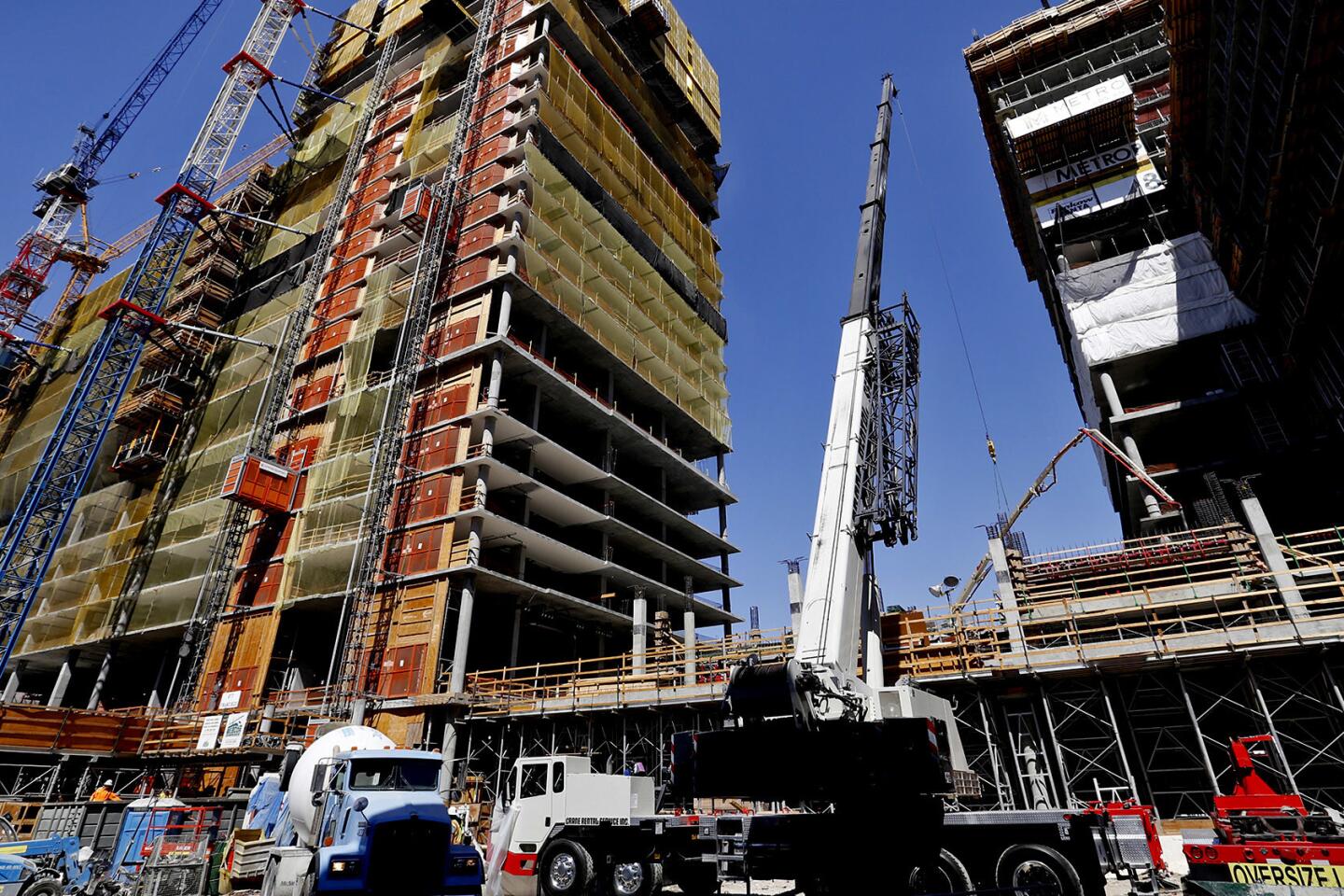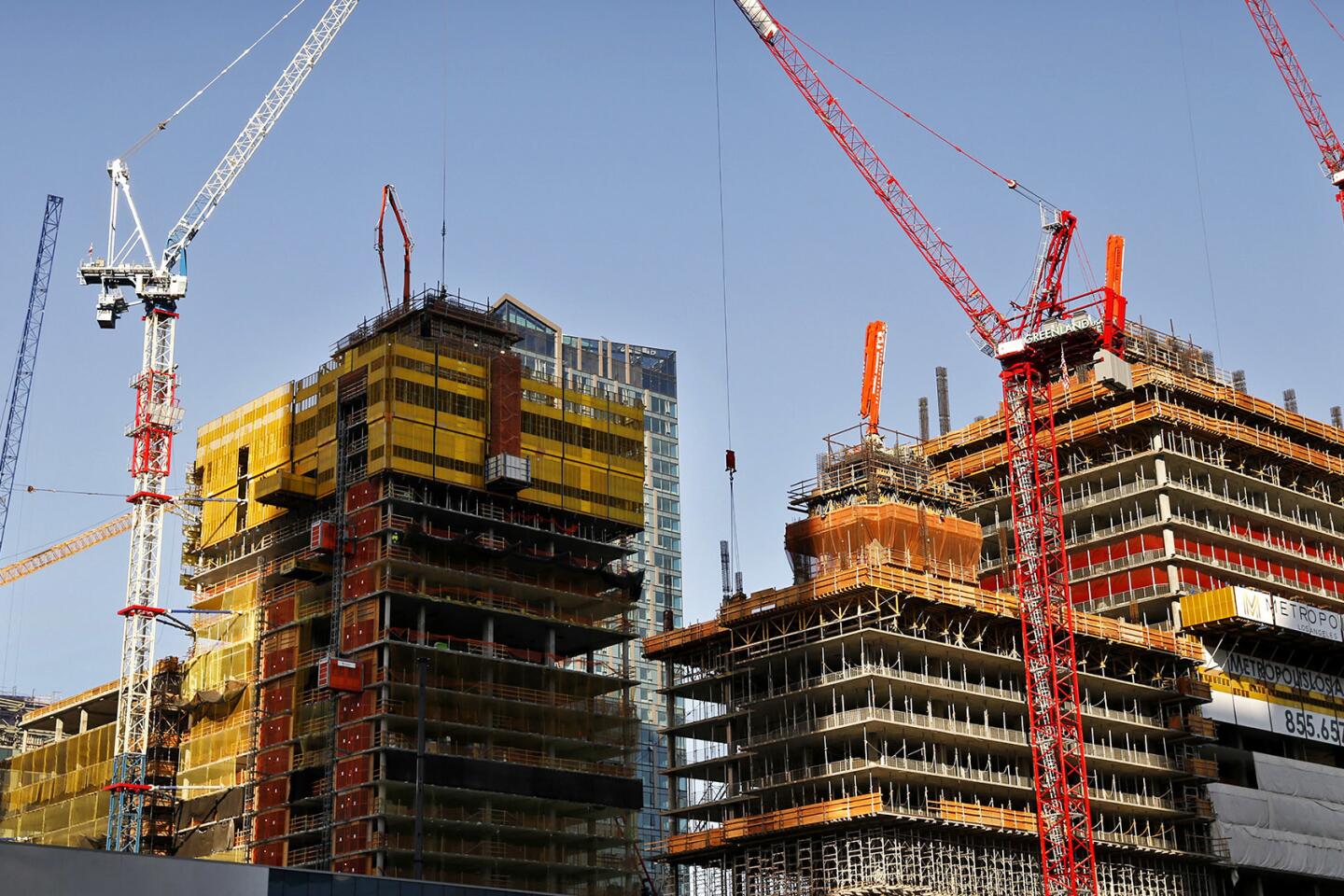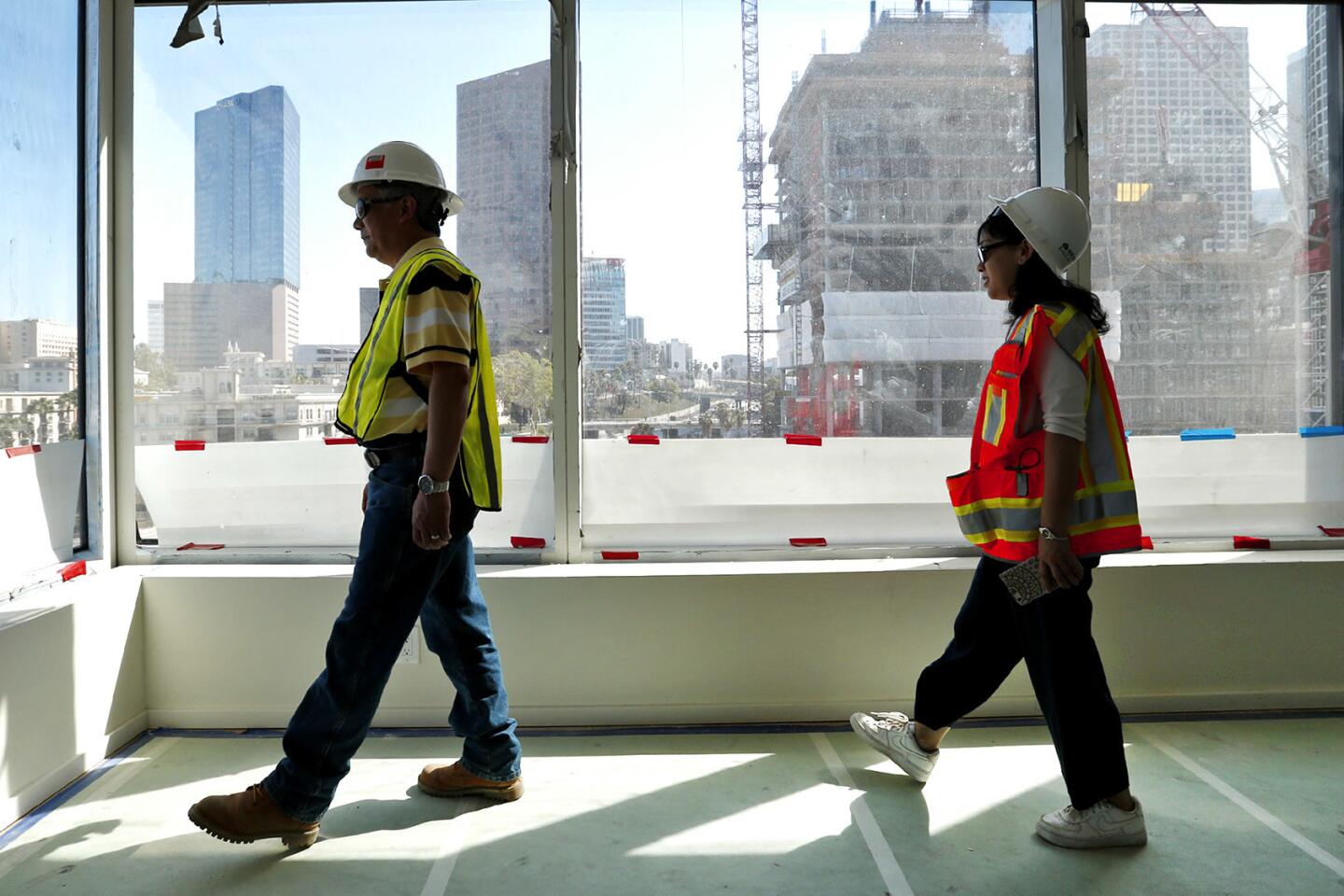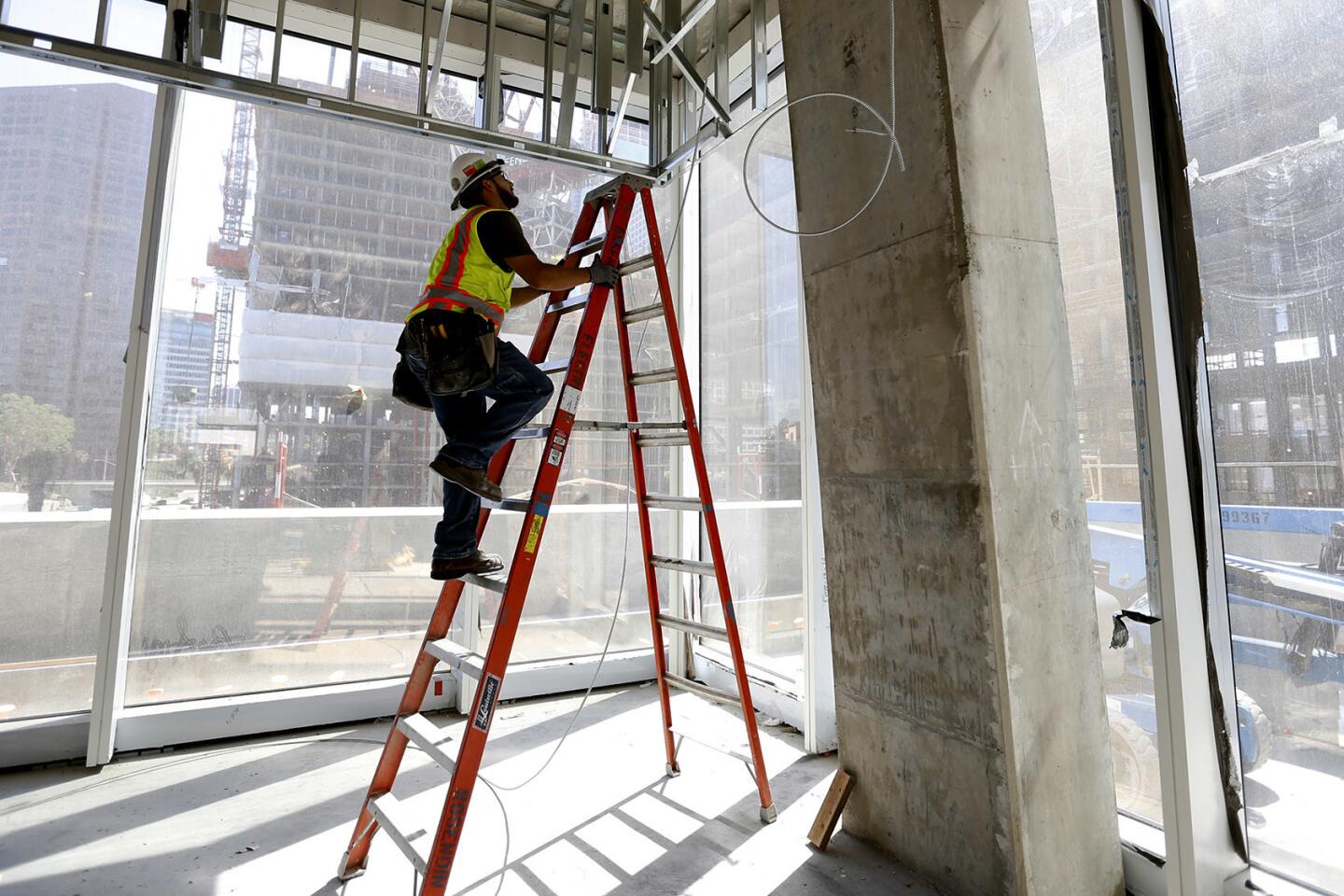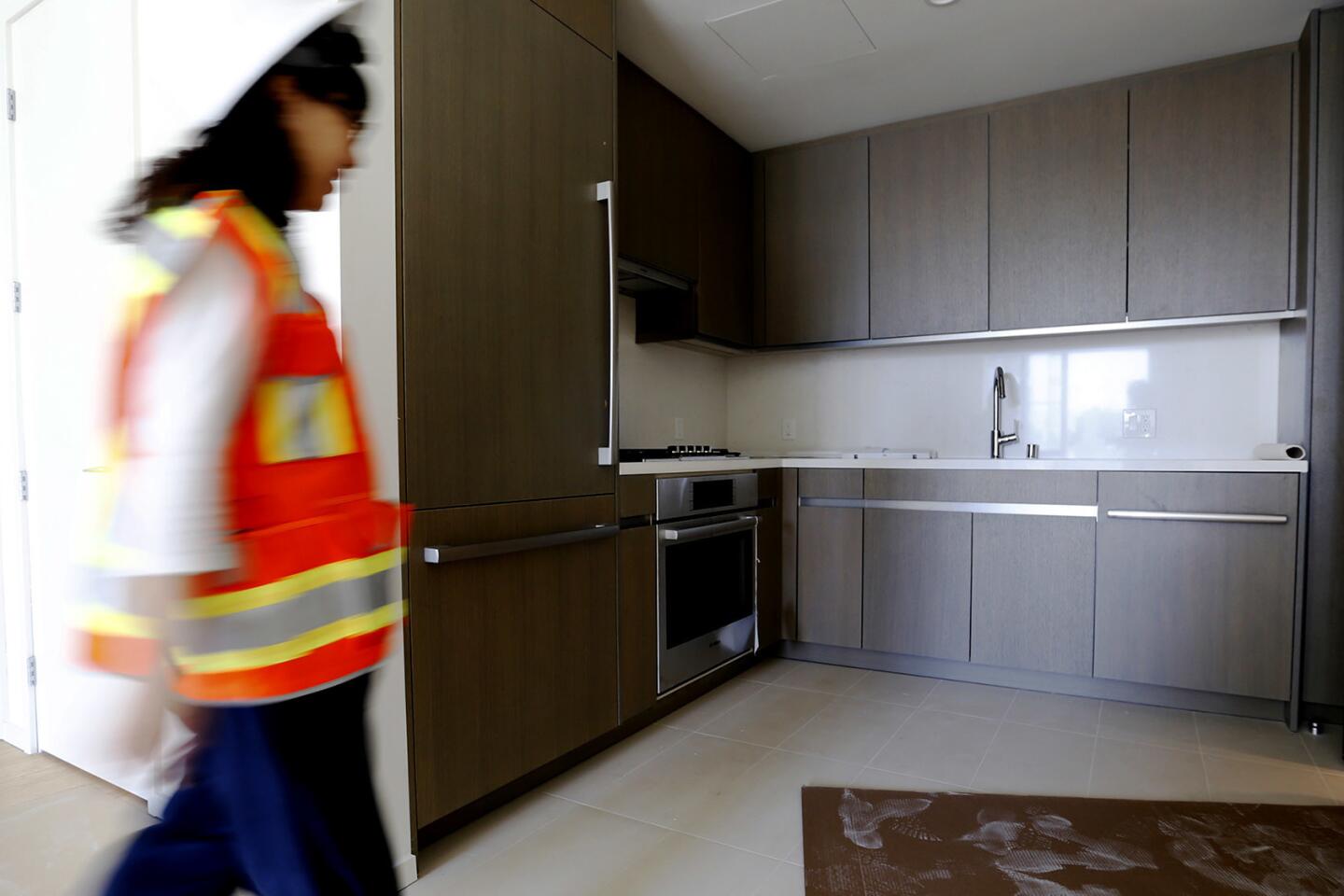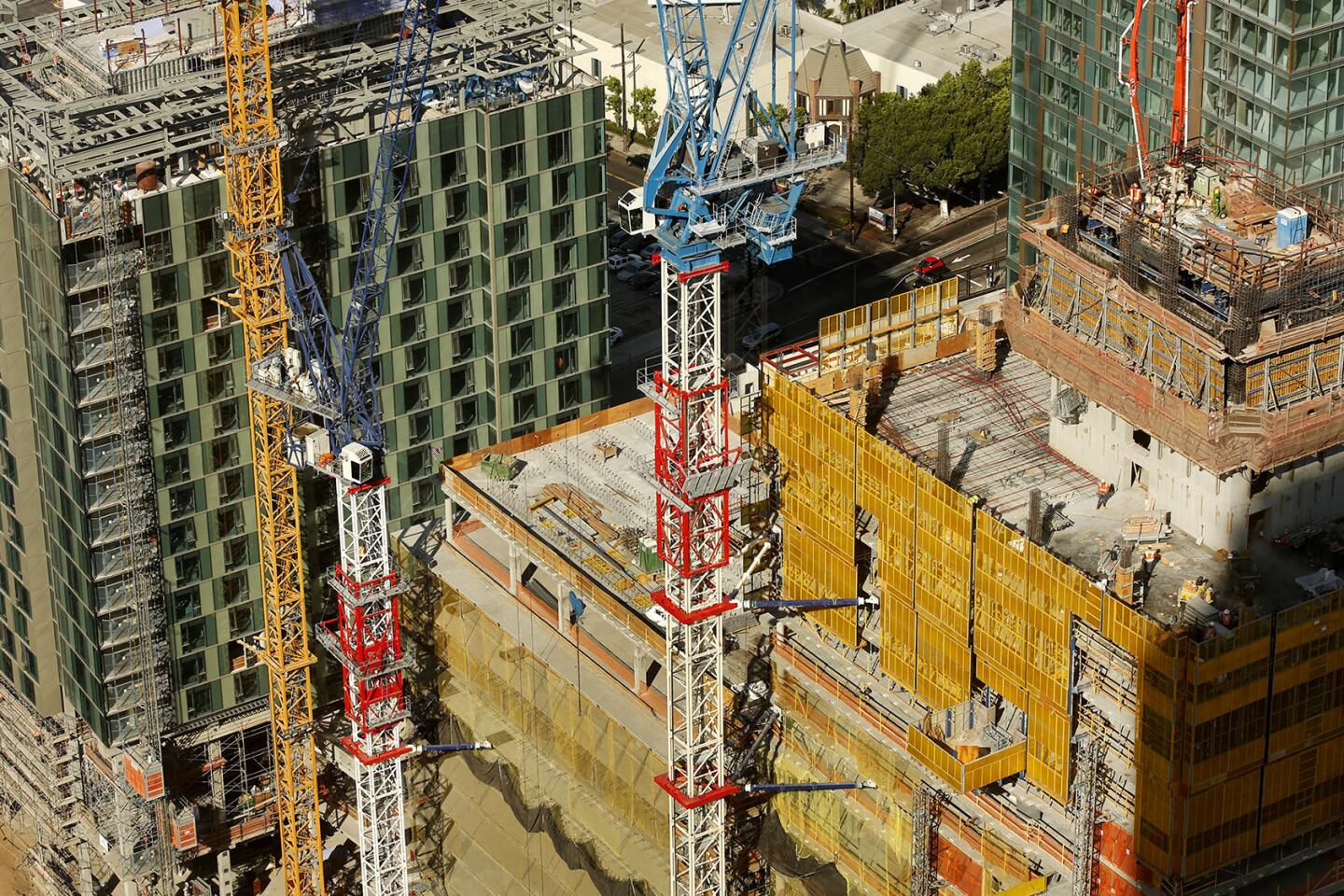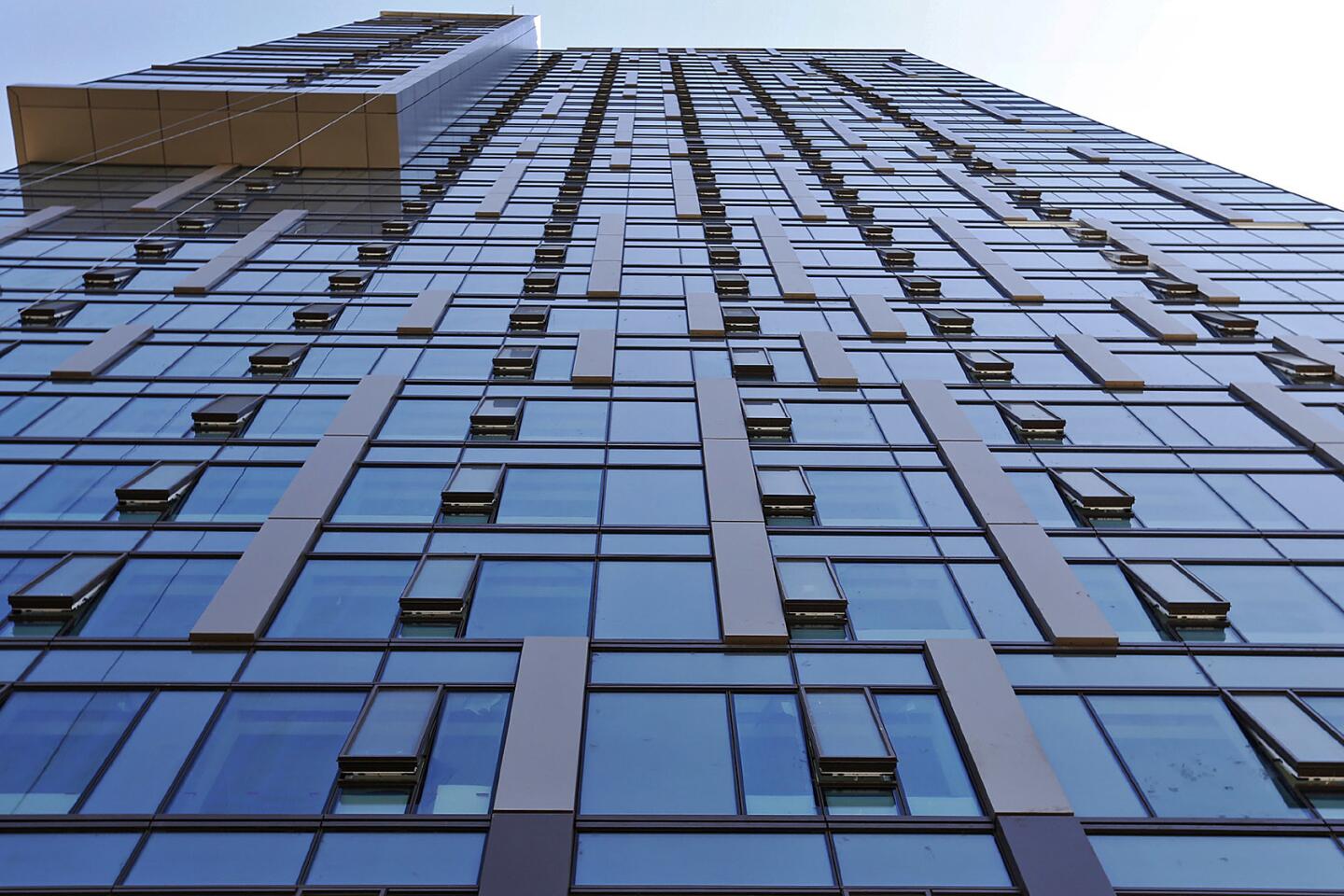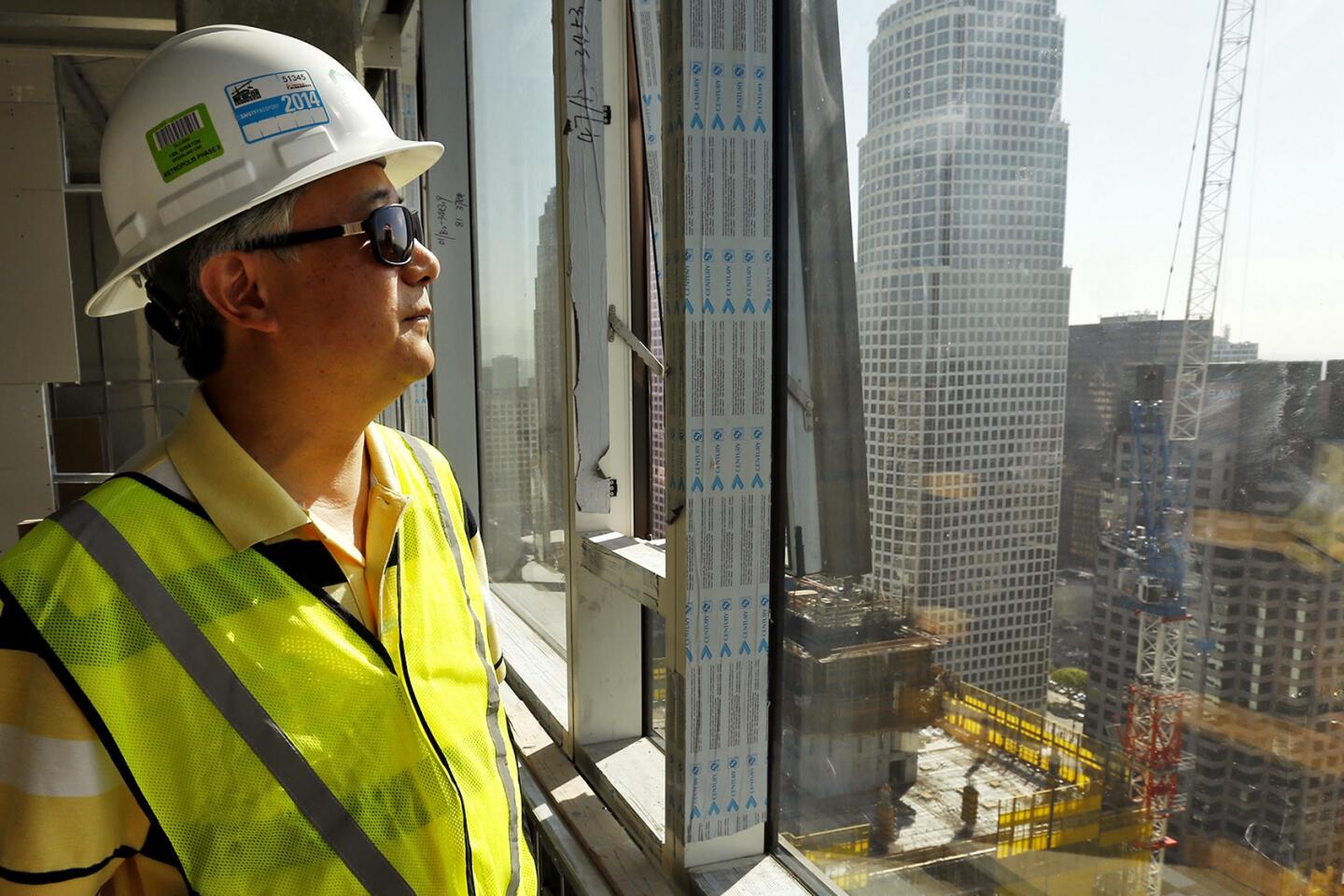They built towering new cities in China. Now they’re trying it in downtown L.A.

Chinese developers are pouring billions into the city which will fundamentally change its downtown skyline.
- Share via
Winston Yan stood atop the largest real estate project of its kind in downtown Los Angeles, a monstrous patchwork of glass and concrete next to the 110 Freeway, and marveled at the bustle of workers, construction vehicles and cranes 38 stories below.
The scope of development in this mixed-use project, called Metropolis, is unprecedented for L.A. but quite familiar to Yan. As an architect and executive for Chinese real estate giant Greenland, he’s witnessed firsthand China’s dramatic urbanization in recent decades.
“It reminds me of what’s happening in Beijing and Shanghai,” said Yan, chief technical officer for Greenland’s U.S. subsidiary. “Now it’s happening here.”
Los Angeles real estate has long attracted foreign investment, be it from Japan, Canada and South Korea. But no one is building from the ground up the way the Chinese are today.
Chinese developers such as Greenland, Oceanwide and Shenzhen Hazens are pouring billions into the neighborhood, adding thousands of new residential units in soaring skyscrapers that will fundamentally change the city’s skyline. Since 2014, Chinese developers have been involved in at least seven of 18 land deals downtown in excess of $19 million, according to real estate firm Transwestern.
“When all these megaprojects are finished, they’re going to have to reshoot the postcard picture of downtown L.A.,” said Mark Tarczynski, executive vice president for Colliers International’s L.A. office.
By investing in Los Angeles, the builders are staking downtown’s revival closer to the Chinese economy. A sizable share of home buyers for the new downtown developments are expected to come from China, where many in the middle and upper class are looking to the perceived safety of foreign real estate to diversify their wealth. That trend has been exacerbated by the uncertainty of China’s slowing economy.
The building boom is something of a showcase for Chinese real estate companies, which are willing to pay a premium to establish themselves as global brands. The foray overseas has also demonstrated the many differences between building in both countries — an experience both sides will need to learn from if the U.S. is to remain a prime destination for Chinese capital.
“The speed is so dramatically different in China,” said Sonnet Hui, executive project director for Shenzhen Hazens, which is building a $700-million mixed-use project across from Staples Center. “There’s a lot of planning and study here, whereas in China it’s just ‘Let’s go, let’s go.’ ”
Before the Chinese landed, things were going nowhere at a 6-acre site on the corner of W. 8th Street and the Harbor Freeway. Plans to develop the parcel, which had been a parking lot, were scuttled by one economic downturn after another.
Then in 2014, Shanghai’s Greenland paid $150 million for the plot and announced plans to build a “city within a city” with about 70,000 square feet of retail space, an 18-story boutique hotel and 1,500 residential units in three condo towers, some with ocean views. They priced properties at $500,000 for the lowest end to $6.9 million for the premier penthouses.
When completed in 2018, the $1-billion project will require a total of 300,000 tons of concrete and 650,000 square feet of glass, much of it in Greenland’s namesake color.
“They need a certain amount of scale to make it worth their while,” said Laurie Lustig-Bower, executive vice president at CBRE and broker for the Metropolis land deal. “Of course, what we consider large is not relatively large to them coming from China.”
When the chairman of Greenland came to visit Metropolis, it was the first time he didn’t require a car to traverse one of his building sites, an executive told Tony Natsis, a partner at Allen Matkins and chairman of the law firm’s real estate practice.
“Their ability to build on this scale is completely child’s play to them,” Natsis said.
Around the same time Greenland bought its site, Oceanwide Holdings, another Chinese real estate giant, paid $174.8 million for a 4.6-acre site across from Staples Center. The Beijing-based builder is in the early stages of another $1-billion mixed-use project, this one with nearly 170,000 square feet of retail space, a luxury hotel and two sleek condo towers that together will offer more than 500 residences.
In a design flourish popular in China, a massive LED screen will wrap the west facing side of Oceanwide Plaza overlooking Figueroa Street. The project is set to open by the end of 2018.
We buy it at the right time and we build right away.
— Thomas Feng, Oceanwide Plazaâs chief executive and president
Across the street are plans for an almost equally extravagant mixed-use development on the current Luxe City Center Hotel site. Shenzhen Hazens is proposing razing the hotel for a pair of gleaming condo towers and a W Hotel steps away from the arena.
“Our chairman [Yan Fuer] is a big basketball fan and went to a game at Staples Center and saw the property and said ‘I want that property,’ ” said Hui, the project’s director.
Shenzhen Hazens paid $104 million for the 2.5-acre site. The $925.11 paid per square foot is the highest of any major land purchase in the area since 2014, according to Transwestern.
The next three highest prices per square foot in the last two years also belong to Chinese buyers. The Greenland, Oceanwide and Shenzhen Hazens developments represent three of the four most expensive land deals downtown, and they highlight the Chinese appetite for splashy and ambitious projects.
“The Chinese can come in with a lot of money and execute deals quickly,” said Michael Soto, an analyst for Transwestern.
Other smaller Chinese projects in the works include Shanghai Construction Group’s proposed 35-story condo tower on 4th Street and Broadway, Fulton Street Ventures’ 28-story condo building at 1133 S. Hope Street and City Century’s 37- and 22-story condo towers at 1201 S. Grand Avenue.
Meanwhile, Lifan Group, a motorcycle manufacturer from the Western Chinese metropolis of Chongqing, paid more than $19 million for a former union hall at the intersection of West 7th and Witmer streets. Naturally, it’s for another apartment high-rise.
Chinese developers can afford to outbid the competition in markets like L.A. because they are willing to wait longer than most to reap returns and can rely on both local and Chinese-based home buyers to scoop up their condos. It’s also advantageous to move capital overseas to hedge against inflation and a weakening Chinese renminbi.
“They look at risk a lot differently because of these factors that relate to what’s going on in China and what’s going on with their currency,” said Tarczynski of Colliers International.
After a boom period that saw property values skyrocket, China’s real estate market has quieted down. Deep-pocketed investors, having exhausted Beijing and Shanghai, looked to foreign markets like Vancouver, Canada; Sydney, Australia; and the San Gabriel Valley to park their cash (some in the belief that China’s economic miracle was due for a reckoning).
Chinese developers followed in kind by building overseas, figuring their brand appeal would extend beyond its borders. Greenland, for example, has developments in Australia, Canada, Malaysia, South Korea, Germany and Spain in addition to U.S. projects in Los Angeles, San Francisco and New York.
That dependence on Chinese buyers could just as easily become a source of risk. Some downtown L.A. residents have expressed concern that Chinese investors will leave their properties empty — a phenomenon common in China and antithetical to the dense urban neighborhood many local boosters have long championed.
Some Chinese developers in L.A. are expecting Chinese buyers to constitute up to 40% of their clients. As a result, they could be beholden to the whims of Chinese regulators who are currently making it harder to get cash out of China — a move prompted by a steep decline in the country’s foreign exchange reserves. That has led to the first drop in Chinese home-buying activity in the U.S. this year since 2011, according to the National Assn. of Realtors.
Chinese firms in L.A. may have to rely on domestic buyers more than they had planned. If so, they’ll have to hope that the surge in construction downtown won’t result in a glut of condos and apartments.
There are 6,260 apartments under construction downtown by all developers, not just Chinese, according to Transwestern. When completed, that will boost the number of existing homes in the neighborhood by 15% to more than 40,000. Thousands more units are planned.
That risk has already steered some major Chinese developers such as Gemdale to forgo downtown and build in Hollywood instead.
“What we have experienced in China is that when there is too much supply coming to the same place, then there will be a stop in investment,” said Jason Zhu, chief executive of Gemdale’s U.S. subsidiary.
Zhu said Gemdale had the luxury of studying the U.S. real estate market for years before making a move.
But for most builders, it has been a steep learning curve. That’s especially true when it comes to the city’s permitting process for building — something that L.A. officials recently streamlined but is considered too time-consuming by the Chinese.
“Chinese developers are not into buying land, letting it sit there for years and waiting for better times,” said Thomas Feng, Oceanwide Plaza’s chief executive and president. “We buy it at the right time and we build right away.”
Part of that disconnect is over safety and planning, which is more stringent in the U.S. But it also underscores the different role real estate plays in the world’s second-largest economy. In China, there’s no real property tax, so local governments rely on land sales for more than a quarter of their revenue. That gives them every incentive to expedite real estate development. (It’s one of the reasons why a 57-story skyscraper can be built in 19 days in China).
That’s not how things are moving in L.A. for Shenzhen Hazens, which still hasn’t broken ground two years after purchasing its land across from Staples Center. The company is still grappling with getting its project entitled.
Raymond Chan, a Los Angeles deputy mayor for economic development who headed the city’s Department of Building and Safety when many of the downtown Chinese projects were first announced, said the city “threw the book” at Shenzhen Hazens at first. Since then, regulators have been more accommodating, seeking ways for the builder to meet all the city’s requirements. The company hopes to have the entitlement completed by early next year.
“It’s been an education,” said Hui of Shenzhen Hazens. “That’s why we have so many attorneys and consultants. Every decision we make is so that we follow U.S. law to a T. … I think the city recognizes that.”
Follow me @dhpierson on Twitter
MORE BUSINESS NEWS
Will Hyundai’s eco-friendly Ioniq woo hearts away from Prius?
Drug companies spend millions to keep charging high prices
Can new chief executive Thomas Dooley fix what’s ailing Viacom?
UPDATES:
2:40 p.m.: This article was updated to clarify that Shanghai Construction Group’s proposed 35-story project on 4th Street and Broadway will include condos, not apartments.
2:05 p.m.: This article was updated to clarify that Transwestern’s tally of 6,260 units currently under construction downtown only includes apartments, not condos.
More to Read
Inside the business of entertainment
The Wide Shot brings you news, analysis and insights on everything from streaming wars to production — and what it all means for the future.
You may occasionally receive promotional content from the Los Angeles Times.

